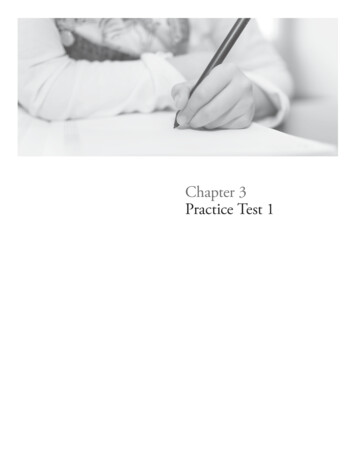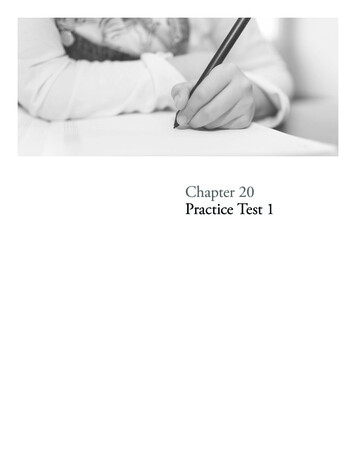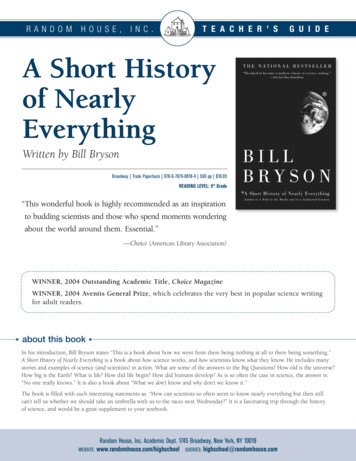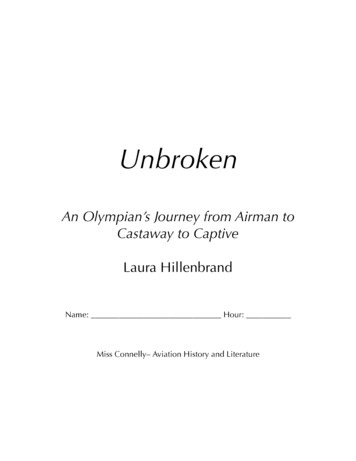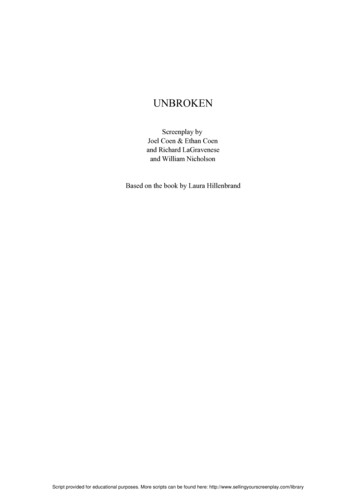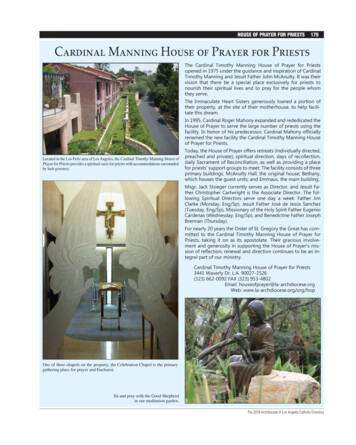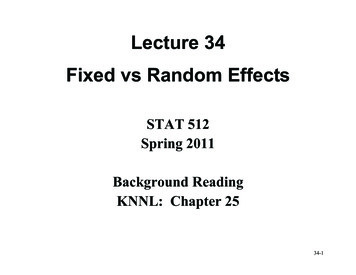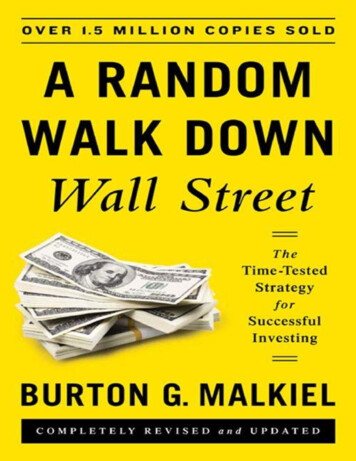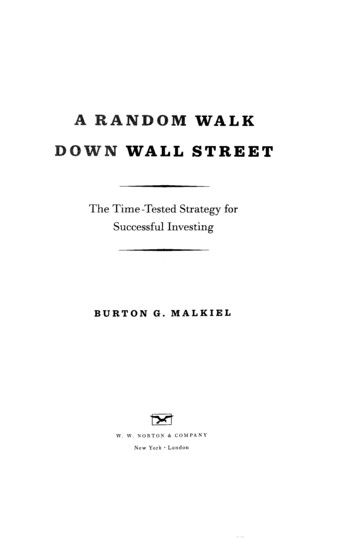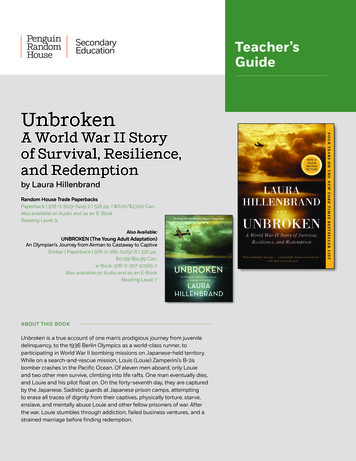
Transcription
SecondaryEducationTeacher’sGuideUnbrokenA World War II Storyof Survival, Resilience,and Redemptionby Laura HillenbrandRandom House Trade PaperbacksPaperback 978-0-8129-7449-2 528 pp. 17.00/ 23.00 Can.Also available on Audio and as an E-BookReading Level: 9Also Available:UNBROKEN (The Young Adult Adaptation)An Olympian’s Journey from Airman to Castaway to CaptiveEmber Paperback 978-0-385-74252-8 320 pp. 10.99/ 14.99 Can.e-Book: 978-0-307-97565-2Also available on Audio and as an E-BookReading Level: 7ABOUT THIS BOOKUnbroken is a true account of one man’s prodigious journey from juveniledelinquency, to the 1936 Berlin Olympics as a world-class runner, toparticipating in World War II bombing missions on Japanese-held territory.While on a search-and-rescue mission, Louis (Louie) Zamperini’s B-24bomber crashes in the Pacific Ocean. Of eleven men aboard, only Louieand two other men survive, climbing into life rafts. One man eventually dies,and Louie and his pilot float on. On the forty-seventh day, they are capturedby the Japanese. Sadistic guards at Japanese prison camps, attemptingto erase all traces of dignity from their captives, physically torture, starve,enslave, and mentally abuse Louie and other fellow prisoners of war. Afterthe war, Louie stumbles through addiction, failed business ventures, and astrained marriage before finding redemption.
Teacher’s Guide for Laura Hillenbrand’s UnbrokenABOUT THE AUTHORNOTE TO THE TEACHERSLAURA HILLENBRAND, born on May 15, 1967, in Fairfax, Virginia, attended KenyonCollege in Ohio. After college she began writing articles and essays for The NewYorker, Vanity Fair, The New York Times and other publications. Her article “A SuddenIllness,” written for The New Yorker, won the National Magazine Award in 2004.Unbroken is her second work of nonfiction. The book was hailed by Time magazine asthe number one nonfiction book of the year in 2010. It also won, among other awards,the Los Angeles Times Book of the Year Award. Both Unbroken and her first nonfictionwork, Seabiscuit, spent weeks at number one on the New York Times bestseller list.Hillenbrand has received the Book Sense Book of the Year Award for Nonfictionand was nominated for the National Book Critics Circle Award for Nonfiction forSeabiscuit. In addition, Seabiscuit inspired the 2003, Academy Award-nominatedmovie of the same name. In 2014, Universal Pictures released a film adaptation ofUnbroken, directed by Angelina Jolie.Hillenbrand’s account of one man’s monumental highs and colossal lows providesa vivid portrait of life as a soldier and prisoner of war (POW) during World War II. Thebook focuses on the role of family, the bonds of friendship, and the power of hope asimportant coping mechanisms in dire situations. The author also explores the role ofphysical and mental conditioning in human resilience and in human depravity.Beyond this, Unbroken is also a powerful informational text, as it tells Louie’s storyagainst the backdrop of major world events of the twentieth century. Louie, theyounger son of a poor family, grows up during the Great Depression. Just before itsonset, Louie scrambles outside predawn to witness the German Graf Zeppelin flyover their California home on its 1929 trip around the world. He participates on theUS Olympic track team (with sprinter Jesse Owens) in Hitler’s 1936 Berlin Olympics.Louie’s military experience is determined by the fallout of December 7, 1941 (theattack on Pearl Harbor), horrific Japanese POW camps, and the atomic bombing ofJapan. He and other former prisoners of war struggle through physical and mentalpostwar torments as the 1951 Treaty of Peace between Japan and the Allied nations,which absolves Japanese war criminals, is signed. Evangelist Billy Graham plays anintegral role in Louie’s redemption. Louie’s return to the 1998 Winter Olympics inNagano, Japan, as the torchbearer, brings his storied life full circle.Supporting the national Common Core State Standards (CCSS) in readinginformational text for high school curriculums, Unbroken is an appropriate selectionfor grades eleven and twelve in Language Arts or US History classes. At the collegelevel, the book is appropriate for US History and Military History courses, and is alsoideal for first-year/common reading programs.In the following “Examining Content Using Common Core State Standards” sectionof this guide, the prompts provide for a critical analysis of Unbroken using theCommon Core State Standards for Informational Text for grades eleven and twelveand are organized according to the standard they primarily support. In addition, atthe end of each standard and the corresponding prompts, a classroom activity isprovided that will enhance analysis of the text.For a complete listing of the Standards, go to: www.corestandards.org/the-standards.2
Teacher’s Guide for Laura Hillenbrand’s UnbrokenEXAMINING CONTENT USING COMMON CORE STATE STANDARDSThe author’s Notes section, beginning on page 417, is an excellent resource for furtherexamination of many of the following prompts.KEY IDEAS AND DETAILSn CCSS ELA-LITERACY.RI.11-12.1 Cite strong and thorough textualevidence to support analysis of what the text says explicitly as well asinferences drawn from the text, including determining where the textleaves matters uncertain.1. How did the Graf Zeppelin’s passengers describe the shadow? What inferencescan be drawn from the shadow’s description and Louie Zamperini’s life? Howdoes this description foreshadow events leading up to the inception of WorldWar II as well as events in Louie’s life?2. Compare and contrast Louie’s view of running as “one more constraint”(Chapter Two, p. 15) with his self-encouragement, “let go” (Chapter Three, p. 35),while running in the 1936 Berlin Olympics. What had constrained Louie?3. As the Green Hornet spiraled downward, Phil thought, “There’s nothing moreI can do,” which left him “strangely devoid of fear.” (Chapter Eleven, p. 124)Louie felt “intensely alive,” even though he knew the plane was doomed.(Chapter Eleven, p. 125) Analyze these feelings. What is the author’s purpose forincluding them? Compare Phil’s and Louie’s thoughts and actions with those ofMcNamara.4. In Chapter Twenty-Three, the reader is introduced to Corporal MutsuhiroWatanabe, who embraces the philosophy of nihilism. Research nihilism andexamine the Corporal’s application of its tenets. A website source can be foundat tiny.cc/Nihilism.5. John Falconer described bombed-out Hiroshima as a beautiful sight. (ChapterThirty-Three, p. 327) Examine why Falconer, in the immediate aftermath ofhis hellish POW experience, would feel this way. Video of the aftermath ofHiroshima and Nagasaki can be viewed at tiny.cc/AtomBomb.CLASSROOM ACTIVITYAfter studying the positions of each soldier aboard the Superman and the GreenHornet, have students watch a video clip of a World War II air battle. As studentsexperience the sights and sounds of World War II air combat, ask them to write streamof-consciousness poems describing their feelings and actions as if aboard a combatplane that is spiraling out of control. What impromptu measures would they take tostay alive/prepare for death?n CCSS ELA-Literacy.RI.11-12.2 Determine two or more central ideas of atext and analyze their development over the course of the text, includinghow they interact and build on one another to provide a complexanalysis: provide an objective summary of the text.1. The Preface to Unbroken recounts an encounter with a Japanese war planestrafing World War II Army Air Force Bombardier Louis Zamperini and his twocrewmates, who are adrift in life rafts in the Pacific Ocean. As the Japanese Zerotargets the drifters on yet another pass, machine guns blazing, Louie dives for3
Teacher’s Guide for Laura Hillenbrand’s UnbrokenCLASSROOM ACTIVITY(CONTINUED)cover under his raft only to notice the presence of sharks coiling upward fromthe depths. As you read Unbroken, examine how this crisis and its resolutionsymbolize most of Louie’s life, especially in terms of the role of physical andmental conditioning in human resilience.2. Compare/contrast the personalities of Louie and Pete. In addition, examine therole Louie’s family plays in Louie’s ability to maintain hope against seeminglyinsurmountable odds.3. As Louie ran the 5,000-meter final in the 1936 Berlin Olympics, he recalleda comment Pete once made: “A lifetime of glory is worth a moment of pain.”(Chapter Three, p. 35) Then, in Louie’s words, he “let go.” (p. 35) In manyways Unbroken is about the experience of letting go. For some, like FrancisMcNamara (Mac), letting go meant succumbing to death. (Chapter 16, p. 171)Develop a position paper, citing further examples from the book that addresseswhat human qualities and conditions are essential to remain resilient againstthe odds.4. Consider the qualities of exceptional leaders. Did Louie demonstrate goodleadership in Unbroken, especially while lost at sea? Support your position usingexamples from the book and other reputable resources.5. Analyze the role the mothers of Louie Zamperini and Mutsuhiro Watanabeplay in the lives of their sons. Cite examples from the text that support theirdedication to their sons. In what ways were their actions similar and in whatways were they different?CLASSROOM ACTIVITYSome say that survival is 80% mental (keeping a positive attitude), 10% skill(knowledge), and 10% equipment (specialized resources). (See the Montclair Collegewebsite below.) While adrift in the Pacific, Louie takes stock of the rafts’ survivalprovisions. (p. 133) He improvises the use of these items to save Phil, Mac, and himself.(p. 164) Conduct a problem-solving survival scenario using groups of four or five. Adaptthe sea/wilderness survival experiential learning activities from the websites below tomeet the developmental needs of students engaged in the reading of Unbroken:Lost at Sea Lesson Plans (COSEE): www.cosee-central-gom.org/seascholars/lesson plans/cruisin/lostatsea lesson.html(The above site provides for a time line for written analysis—a Common Core State Standards requirement.)Survival Lesson Plan (Monclair State University): tiny.cc/SurvivalLessonPlanBasic Survival Skills (Alderleaf Wilderness College): mlThree Things Required for Survival in Any Situation tuation/n CCSS ELA-LITERACY.RI.11-12.3 Analyze a complex set of ideas orsequence of events and explain how specific individuals, ideas, orevents interact and develop over the course of the text.1. While reading Unbroken, create a character chart on Louie and on MutsuhiroWatanabe. Log their thoughts, plans, words, feelings, deeds, actions, strengths,and weaknesses. Then, analyze the relationships and events that cause themto change over time. In what ways do they remain unchanged? Janet Allen’s4
Teacher’s Guide for Laura Hillenbrand’s UnbrokenCLASSROOM ACTIVITY(CONTINUED)Yellow Brick Roads (Portland, MA: Stenhouse Publishers, 2000) providescomprehensive character chart graphic organizers.2. In Chapter Nineteen, the author quotes from the 1941 Japanese Military FieldCode that soldiers should die, rather than live with the shame of imprisonment.Read more excerpts from the Japanese Military Field Code at tiny.cc/FieldCode.Analyze the ideal Japanese soldier based on the contents of this code, includinghow he was to treat captives. Compare and contrast the ideal with the Japanesesoldiers described in Unbroken.3. In Chapter Twenty-Four, the reader is introduced to Japanese Private YukichiKano. Kano aids as many POWs in Omori as he can, risking his own life. Medalof Honor recipient Pappy Boyington wrote, “’[His] heart was being torn outmost of the time, a combination of pity for the ignorance and brutality of someof his own countrymen and a complete understanding of the suffering of theprisoners.” (p. 251) In his own way, Kano resisted the regime. Develop a position asto why there was little organized resistance to the Japanese World War II regimeas compared to the European regimes. For a brief overview of Japan’s reasonfor entering the war, go to tiny.cc/JapanWWII. Also, Leaves from the Autumnof Emergencies: Selections from the Wartime Diaries of Ordinary Japanese, bySamuel Yamashita, and Hiroshima, by John Hersey provide human perspectiveson the daily lives of ordinary Japanese citizens during the war.4. Throughout Unbroken, the author describes the brutality of Japanese prisonpersonnel toward their captives. Compare this treatment with the Nazitreatment of prisoners of war. Develop a position as to which Axis power wascrueler. Support your conclusions using examples from the book and otherreputable sources. Hillenbrand cites a number of references on page 448 of theNotes section of Unbroken. In addition, ask students to search online for WorldWar II prisoners of war data.CLASSROOM ACTIVITYDebate Option One: American POWs in Japanese prison camps were subjectedto waterboarding as a means of obtaining classified enemy information. Researchthe technique of waterboarding, including its use by United States intelligenceagencies. Conduct a classroom debate concerning whether or not waterboarding is aninterrogation tool or a form of torture. This debate activity can be extended to introduceand discuss interrogation methods in other countries.Debate Option Two: In the Epilogue, the author delineates the reasons the UnitedStates lifted the retribution of Japanese war criminals. Discuss those reasons, and thensupport or refute the lift using examples from the book and other reputable sources.ccss: craft and structureCRAFT AND STRUCTUREn CCSS.ELA-LITERACY.RI. 11-12.4 Determine the meaning of words andphrases as they are used in a text including figurative, connotative,and technical meanings: analyze how an author uses and refines themeaning of a key term or terms over the course of a text (e.g.
Unbroken A World War II Story of Survival, Resilience, and Redemption by Laura Hillenbrand Unbroken is a true account of one man’s prodigious journey from juvenile delinquency, to the 1936 Berlin Olympics as a world-class runner, to participating in World War II bombing missions on Japanese-held territory.
